It looks like you're using an Ad Blocker.
Please white-list or disable AboveTopSecret.com in your ad-blocking tool.
Thank you.
Some features of ATS will be disabled while you continue to use an ad-blocker.
18
share:
I just came across a relatively new YouTube video from the Rethinking series by Alex Mott in which the Incan stonework in Peru is being
discussed. When skipping the introduction and watching from the 5 minute mark, they show (based on a model) how the polygonal walls in Cuzco
could have been built by non-traditional means.
The procedure involves a chemical which would have been used to soften the exterior of a rough-hewn rock in order to fit it into the complex geometric pattern of the existing parts of the wall. There has been an earlier thread on this theory, but seeing this done on a model (and seeing the effects this produces in neighboring stones) helps imagining how this architectural style could have been achieved, but have a look yourself:
If you prefer to watch it on YouTube directly (starting at the 5 minute mark) please click here.
Below you'll find a series of images illustrating the process; a model of the wall with a polygonal gap in the middle is the starting configuration. Then a rough-hewn block from the quarry receives chemical treatment on the outside to soften the exterior faces. Its weight ultimately fits it perfectly into the existing contours, the excess material is being scraped away once the block is in place:
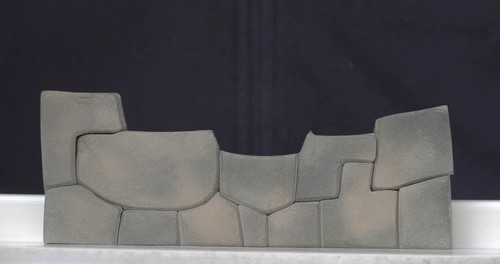
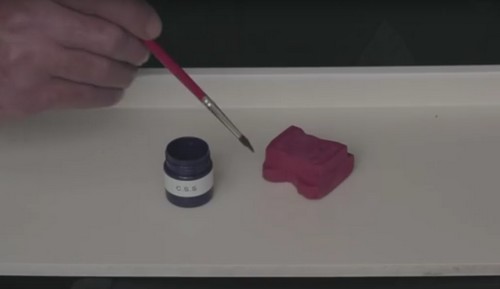
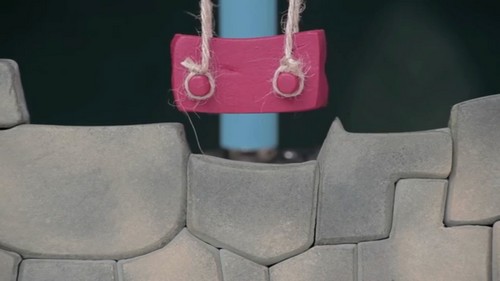
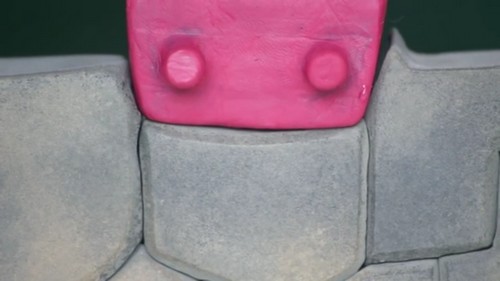


Interestingly, the procedure produces the same artifacts that can be seen on the actual walls (including the typical bevelling effect, the imprints on the faces that often look as if the stone was softened and other features we know from Incan style architecture):
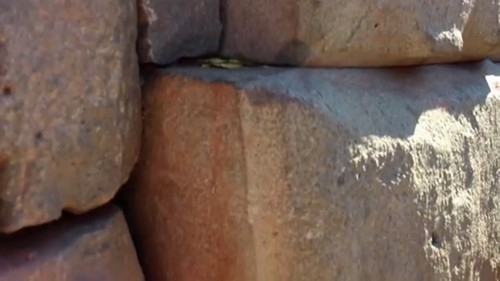
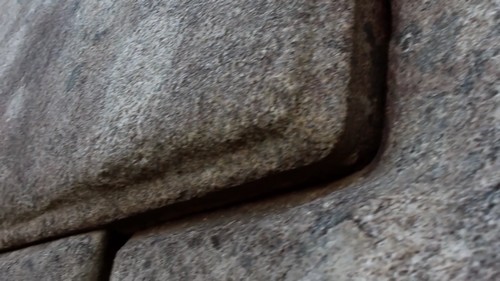
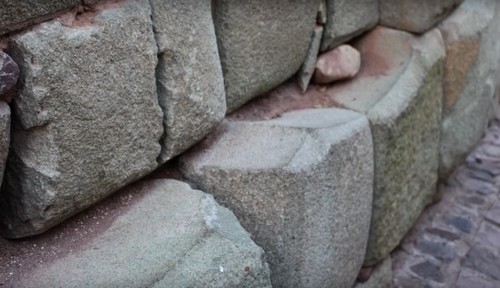
Of course one could argue that the same features/artifacts would be visible when applying the traditional methods (chiseling and pounding) but in that case one wouldn't expect the effect to be so regular, smooth and consistent. In other words: with labourious chiseling we shouldn't be seeing the tight fit and bevelling on vast portions of the Incan stonework.
The traditional methods of quarrying and working the stones in Peru have extensively been analyzed by J.P. Protzen (see here for his paper on Incan masonry). Of course we are left with many questions about if and how such acidic chemicals would have been available to the Incas and, if it was taken from a local plant, how could they could have accessed so much of it to soften thousands of megalithic blocks that way.
And above all: could an analysis of the top-layers of the rocks prove that a chemical has been used to dissolve the surface? I thought this topic would be a good fit for the A&LC board and I look forward to your thoughts and opinions!
SOURCES AND LINKS:
------------------------------------------
01. Rethinking: Peru (Video)
02. Inca Quarrying and Stonecutting (J.P. Protzen)
03. Thread: The Plant That Softens Stone
04. David Pratt: Lost Civilizations of the Andes
05. Daily Grail: Rethinking the Mysteries of Peru
The procedure involves a chemical which would have been used to soften the exterior of a rough-hewn rock in order to fit it into the complex geometric pattern of the existing parts of the wall. There has been an earlier thread on this theory, but seeing this done on a model (and seeing the effects this produces in neighboring stones) helps imagining how this architectural style could have been achieved, but have a look yourself:
If you prefer to watch it on YouTube directly (starting at the 5 minute mark) please click here.
Below you'll find a series of images illustrating the process; a model of the wall with a polygonal gap in the middle is the starting configuration. Then a rough-hewn block from the quarry receives chemical treatment on the outside to soften the exterior faces. Its weight ultimately fits it perfectly into the existing contours, the excess material is being scraped away once the block is in place:






Interestingly, the procedure produces the same artifacts that can be seen on the actual walls (including the typical bevelling effect, the imprints on the faces that often look as if the stone was softened and other features we know from Incan style architecture):



Of course one could argue that the same features/artifacts would be visible when applying the traditional methods (chiseling and pounding) but in that case one wouldn't expect the effect to be so regular, smooth and consistent. In other words: with labourious chiseling we shouldn't be seeing the tight fit and bevelling on vast portions of the Incan stonework.
The traditional methods of quarrying and working the stones in Peru have extensively been analyzed by J.P. Protzen (see here for his paper on Incan masonry). Of course we are left with many questions about if and how such acidic chemicals would have been available to the Incas and, if it was taken from a local plant, how could they could have accessed so much of it to soften thousands of megalithic blocks that way.
And above all: could an analysis of the top-layers of the rocks prove that a chemical has been used to dissolve the surface? I thought this topic would be a good fit for the A&LC board and I look forward to your thoughts and opinions!
SOURCES AND LINKS:
------------------------------------------
01. Rethinking: Peru (Video)
02. Inca Quarrying and Stonecutting (J.P. Protzen)
03. Thread: The Plant That Softens Stone
04. David Pratt: Lost Civilizations of the Andes
05. Daily Grail: Rethinking the Mysteries of Peru
edit
on 29-1-2017 by jeep3r because: formatting and URL added
a reply to: jeep3r
Best Topic of the day so far... S+F! You had my curiosity at chemical (which I was actually thinking for a long time), but you got my full attention at 'Magnetism!' I wish it elaborated more on those aspects though... beyond just indicating magnetic fields alter the natural course of lives. And maybe more about the specific chemical softeners found to be successful?
Looks like it may be time to get some science experiments going...
Best Topic of the day so far... S+F! You had my curiosity at chemical (which I was actually thinking for a long time), but you got my full attention at 'Magnetism!' I wish it elaborated more on those aspects though... beyond just indicating magnetic fields alter the natural course of lives. And maybe more about the specific chemical softeners found to be successful?
Looks like it may be time to get some science experiments going...
a reply to: jeep3r
Quick comment before watching. I love the Incan masonry. I remember reading that the method of molding the edges had been discovered by observing a partular bird that built its nest on rock outcroppings by blending the exudite of 2 different plants , which in turn softened the stone allowing it to be scooped out inro a bowl more or less.
I always liked the theory that phytochemistry could of been used to achieve the end result.
Quick comment before watching. I love the Incan masonry. I remember reading that the method of molding the edges had been discovered by observing a partular bird that built its nest on rock outcroppings by blending the exudite of 2 different plants , which in turn softened the stone allowing it to be scooped out inro a bowl more or less.
I always liked the theory that phytochemistry could of been used to achieve the end result.
a reply to: jeep3r
Good thread
Those walls represent a mystery for more than one reason. The Incas adopted the technique from older cultures. In some cases they not even built the walls. Sacsayhuaman for example.
As far as I remember, coca was the main ingredient for the rock melting formula.
I'll revisit this thread when I am back home.
Good thread
Those walls represent a mystery for more than one reason. The Incas adopted the technique from older cultures. In some cases they not even built the walls. Sacsayhuaman for example.
As far as I remember, coca was the main ingredient for the rock melting formula.
I'll revisit this thread when I am back home.
originally posted by: Trueman
a reply to: jeep3r
Those walls represent a mystery for more than one reason. The Incas adopted the technique from older cultures. In some cases they not even built the walls. Sacsayhuaman for example.
As far as I remember, coca was the main ingredient for the rock melting formula.
David Pratt has some information on his site about the alleged plant which is said to be capable of softening stone:
Lost Civilizations of the Andes
In Peru, above 4500 m, there is said to be a plant called kechuca which turns stone to jelly, and which the jakkacllopito bird uses to make its nest. A plant with similar properties that grows at even higher altitudes is known, among other things, as punco-punco; this may be Ephedra andina, which the Mapuche consider a medicinal plant
I'm not sure, though, if there is any information out there to prove that this could in fact have been used on a large scale to dissolve said rocks (granite, andesite and limestone).
Fantastic I'm a gonna put some magnets in my vege garden.
And now I'm going to mix up some raw cacoa powder and try it on some rock.
Great thread thanks for sharing and caring.
Maybe trueman meant the place t they make a certain drug with. Oops
And now I'm going to mix up some raw cacoa powder and try it on some rock.
Great thread thanks for sharing and caring.
Maybe trueman meant the place t they make a certain drug with. Oops
edit on 29-1-2017 by Cloudbuster because: Added extra info
originally posted by: Cloudbuster
Fantastic I'm a gonna put some magnets in my vege garden.
And now I'm going to mix up some raw cacoa powder and try it on some rock.
Great thread thanks for sharing and caring.
Maybe trueman meant the place t they make a certain drug with. Oops
Haha...., I actually lived in Peru many years. Coca is widely used for medicinal and nutritional reasons there, perfectly legal. I made a thread long time ago about coca.
www.abovetopsecret.com...
I also mentioned one time somewhere here about that bird that jepp3r quoted. I believe the procedure to create the rock melting mix includes "Chacchar" (chew) part of the ingredients.
Most of the pics show scribing and fitting the stone, which is certainly true enough, but the claim that the stone was "softened" is completely
lacking in proof. After reading numerous claims of a plant or plants "softening" stone over the years, there has never been a comprehensive
demonstration of this. Just anecdotes.
a reply to: jeep3r
I'm thinking that's a far fetched theory,if they can cut the rock's at different,shapes and sizes,and could liquify the rock,seem there would be walls with no seams,may have had some liquid mortar,but look to mew most joints were mortarless,to be able to move under sesmic activity,and return to original form
I'm thinking that's a far fetched theory,if they can cut the rock's at different,shapes and sizes,and could liquify the rock,seem there would be walls with no seams,may have had some liquid mortar,but look to mew most joints were mortarless,to be able to move under sesmic activity,and return to original form
It's a mystery for sure.
I personally find it hard to believe a plant or 2 combined, can melt rock.
I personally find it hard to believe a plant or 2 combined, can melt rock.
originally posted by: burgerbuddy
It's a mystery for sure.
I personally find it hard to believe a plant or 2 combined, can melt rock.
I think (hope) that the idea is that they chemically softened (degraded) the outside surfaces where necessary in order to be able to more quickly and efficiently shape those surfaces to fit, and not that the entire stone was liquefied and then poured into place. That definitely wouldn't work, for reasons that I think (hope) don't really need to be enumerated.
Harte
originally posted by: Harte
originally posted by: burgerbuddy
It's a mystery for sure.
I personally find it hard to believe a plant or 2 combined, can melt rock.
I think (hope) that the idea is that they chemically softened (degraded) the outside surfaces where necessary in order to be able to more quickly and efficiently shape those surfaces to fit, and not that the entire stone was liquefied and then poured into place. That definitely wouldn't work, for reasons that I think (hope) don't really need to be enumerated.
Harte
Don't you think they would find melted rocks around and under these plants in the wild?
I don't know how they fitted the rocks but turning part of it into putty with plants is quite a stretch.
And how long did it take to dawn on them that this jigsaw puzzle design is best for quakes?
Why the need for walls in the first place? Dragons?
new topics
-
'Mass Casualty event' - Attack at Christmas market in Germany
Mainstream News: 1 hours ago -
Search to Resume for MH 370
Disaster Conspiracies: 3 hours ago -
Sue Gray, Sir Keir Starmer's former Chief of Staff, Nominated for Peerage
Regional Politics: 5 hours ago -
Biden Nationalizes Another 50,000+ Student Loans as He Heads for the Exit
US Political Madness: 5 hours ago
top topics
-
'Mass Casualty event' - Attack at Christmas market in Germany
Mainstream News: 1 hours ago, 15 flags -
An Interesting Conversation with ChatGPT
Science & Technology: 15 hours ago, 8 flags -
Biden Nationalizes Another 50,000+ Student Loans as He Heads for the Exit
US Political Madness: 5 hours ago, 7 flags -
Sue Gray, Sir Keir Starmer's former Chief of Staff, Nominated for Peerage
Regional Politics: 5 hours ago, 2 flags -
Search to Resume for MH 370
Disaster Conspiracies: 3 hours ago, 2 flags
active topics
-
'Mass Casualty event' - Attack at Christmas market in Germany
Mainstream News • 15 • : chr0naut -
Can someone 'splain me like I'm 5. Blockchain?
Science & Technology • 90 • : Ravenwatcher -
Russias War Against Religion in Ukraine
World War Three • 54 • : andy06shake -
Search to Resume for MH 370
Disaster Conspiracies • 3 • : chr0naut -
Drone Shooting Arrest - Walmart Involved
Mainstream News • 36 • : imitator -
-@TH3WH17ERABB17- -Q- ---TIME TO SHOW THE WORLD--- -Part- --44--
Dissecting Disinformation • 3768 • : Thoughtful3 -
Have you noticed?? Post Election news coverage...
World War Three • 10 • : chr0naut -
An Interesting Conversation with ChatGPT
Science & Technology • 21 • : Flyingclaydisk -
US Federal Funding set to Expire December 20th. Massive CR on the way.
Mainstream News • 45 • : marg6043 -
Biden Nationalizes Another 50,000+ Student Loans as He Heads for the Exit
US Political Madness • 5 • : Dalamax
18
